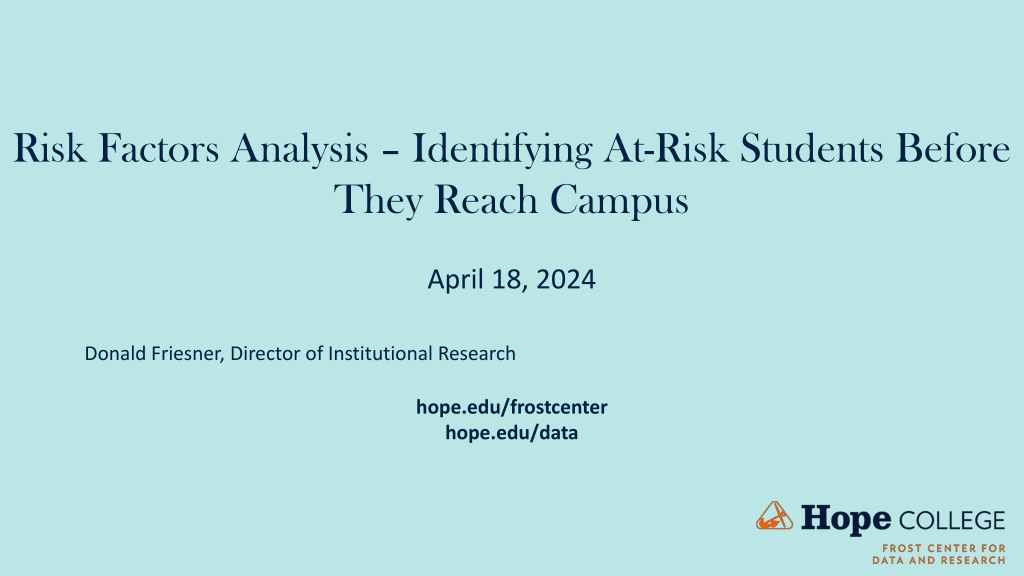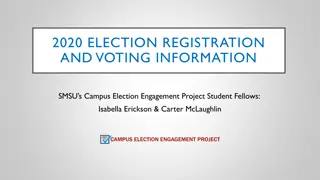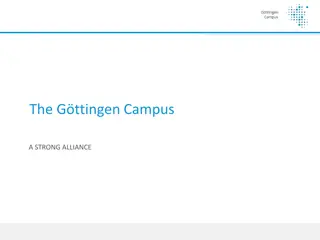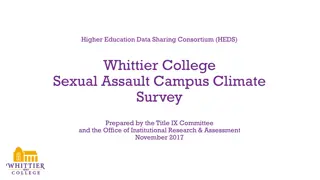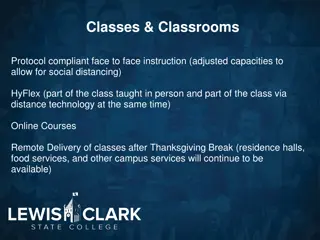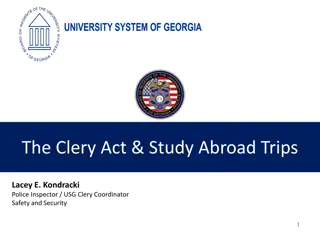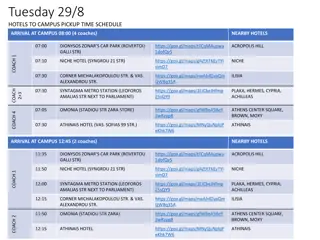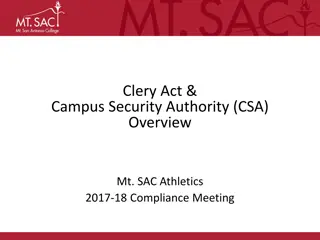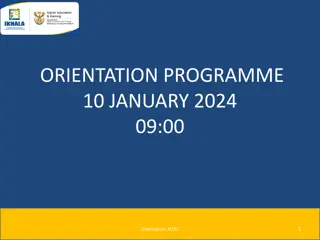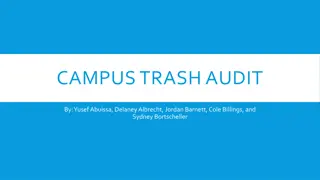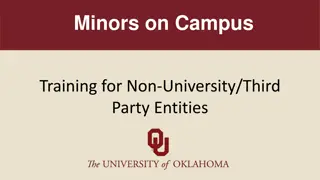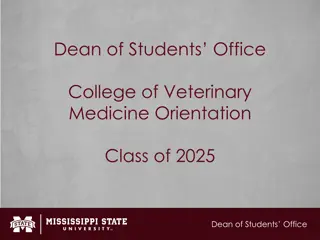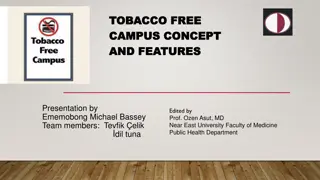Risk Factors Analysis: Identifying At-Risk Students Before They Reach Campus
Risk Factors Analysis aims to identify students at risk of attrition before they even arrive on campus by evaluating academic, financial, minority, and first-generation factors. The method involves choosing specific risk factors, tracking historical prevalence, calculating relative risk, and predicting retention rates. By targeting at-risk students early, intervention can be implemented effectively to prevent issues before they escalate.
Download Presentation

Please find below an Image/Link to download the presentation.
The content on the website is provided AS IS for your information and personal use only. It may not be sold, licensed, or shared on other websites without obtaining consent from the author. Download presentation by click this link. If you encounter any issues during the download, it is possible that the publisher has removed the file from their server.
E N D
Presentation Transcript
Risk Factors Analysis Identifying At-Risk Students Before They Reach Campus April 18, 2024 Donald Friesner, Director of Institutional Research hope.edu/frostcenter hope.edu/data
Risk Factors Analysis A simple method for determining students at risk for attrition before they arrive on campus A way to measure the impact of individual risk factors A way to measure the impact of multiple risk factors
Method Choose a set of risk factors from literature (academic, financial, minority, first generation) Academic Risk Factor Academic Risk Factor A large drop-off in retention with HS GPA under 3.3 Low Income Risk Factor Low Income Risk Factor - Pell Eligible Minority Risk Factor Minority Risk Factor - Minority Status First Generation Risk Factor First Generation Risk Factor - Neither Parent any College - From FAFSA Identify students with risk factor(s) Track historic prevalence and impact on retention Calculate Relative Risk Predict future retention based on incoming class
Risk Factors Analysis A simple method for determining students at risk for attrition before they arrive on campus A way to measure the impact of individual risk factors A way to measure the impact of multiple risk factors
Use Literature indicates early intervention has the most impact By the time a student struggles in their first year intervention is likely too late Risk Factors Analysis identifies incoming students likely to be at risk for attrition Gives ability to reach out to at risk students with intervention specific to their risk factor(s) BEFORE issues arise
Impact of Risk Factors - Retention Rates for Those With and Without Risk Factor Analysis uses First Time in Any College (FTIAC) cohorts from Fall 2018 through Fall 2022
Academic Risk Factor Relative Risk Present? Attrition Retain Total Retention Yes 80 304 384 79.2% No 348 3,322 3,670 90.5% Total 428 3,626 4,054 89.4% 2.20 Source: Application A cut off at HSGPA of 3.3 for factor
Low Income Risk Factor Relative Risk Present? Attrition Retain Total Retention Yes 110 644 754 85.4% No 324 3,025 3,362 90.0% Total 434 3,682 4,116 89.5% 1.51 Source: Financial Aid , Banner. Students who ACCEPTED Pell Grants
Minority Risk Factor Relative Risk Present? Attrition Retain Total Retention Yes 96 613 709 86.5% No 338 3,069 3,407 90.1% Total 434 3,682 4,116 89.5% 1.36 Source: Banner Student Records
First Generation Risk Factor Relative Risk Present? Attrition Retain Total Retention Yes 103 542 645 84.0% No 331 3,140 3,471 90.5% Total 434 3,682 4,116 89.5% 1.67 Source: Application
Retention by Number of Risk Factors # of Risk Factors Retention rate 91.8% 88.1% 81.6% 82.8% 84.0% 89.5% Percent of total 60.3% 25.0% Attrit Retained 2,279 907 306 169 Total 2,482 1,030 375 204 0 1 2 3 4 203 123 69 35 9.1% 5.0% 0.6% 4 21 25 Total 434 3,682 4,116 100.0% Note that 14.7% of the population have 2 or more risk factors (9.1%+5.0%+.6%). With an entering class of 900 students, 133 students would be expected to have 2 or more risk factors (900*.147=132.3).
A Comparison (or, how I expected it to work) Hope College, 2018-2022 Cohorts CMU, 2008-2012 Cohorts # of Risk Factors Retention rate Percent of total # of Risk Factors Retention rate Percent of total Attrit Retained Total Attrit Retained Total 0 203 2,279 2,482 91.8% 60.3% 0 1,956 8,372 10,328 81.1% 54.6% 1 123 907 1,030 88.1% 25.0% 1 1,459 4,288 5,747 74.6% 30.4% 2 69 306 375 81.6% 9.1% 2 713 1,460 2,173 67.2% 11.5% 3 35 169 204 82.8% 5.0% 3 230 327 557 58.7% 2.9% 4 4 21 25 84.0% 0.6% 4 46 59 105 56.2% 0.6% Total 434 3,682 4,116 89.5% 100.0% Total 4,404 14,506 18,910 76.7% 100.0%
And now for something completely different Monty Python
Retention and Number of Activities Activity Count 1-Year 88.0% 87.3% 94.6% 96.4% 97.8% 98.8% 100.0% 100.0% 100.0% 100.0% 2-Year 84.2% 81.0% 89.2% 92.1% 95.5% 98.8% 96.8% 100.0% 100.0% 100.0% 3-Year 85.2% 79.2% 86.7% 89.3% 93.5% 97.3% 96.4% 80.0% 100.0% 100.0% 4-Year 84.6% 77.0% 86.2% 87.0% 92.9% 93.8% 90.0% 100.0% 0.0% 100.0% 0 1 2 3 4 5 6 7 8 9 Only 1-5 students per cell in these rows
